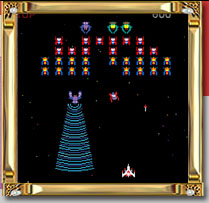
 |
|
 |
 |
|||
|
If you were a lad turning towards teenhood during the early 80s you were in line for a confusing experience. Your body was changing in ways you didn't understand. You were becoming attracted to the opposite sex but 20 years of transformative gender politics had rendered the previous laws of courtship moot. You were struggling to comprehend what drove the strange social hierarchy that defined some kids as "cool" and other kids as "nerds." And you were beginning to understand that you wouldn't be a child forever... the world of adulthood was rushing towards you! Even worse: arcade games! Which one should you play? It was a landscape besotted with blinking, beeping, boxy monstrosities. Robotron, Pac Man, Centipede, Donkey Kong... even that old stalwart Space Invaders was still making the scene. But for those of us with a certain sensibility, only one game could command our loyalty (and our endless hours and quarters.) That game was Galaga. This might seem a baffling statement at first. After all, Galaga was quite similar to many of the "space war" themed video games. Like Space Invaders, you controlled a spaceship that could only operate on the y-axis at the bottom of the screen. Your ship would be attacked by hordes of enemy combatants who flew about in curious patterns. As you dodged their incoming rockets, you pounded away at the fire button to blast your attackers out of the sky. After every six or so alien onslaughts, you would get a bonus round where you could accumulate points by wiping out enemy spaceships who couldn't fire back. (Thereby teaching an entire generation the joy of picking on those weaker than you.) Perhaps the most singular feature of Galaga was that if one of your ships was captured by an alien tractor beam, you could free it and then have two spaceships joined together at the hip with twice the firepower. All pretty standard arcade fare... what made Galaga really stand out? It was partly the pacing of the game --- much faster than S.I. and other contemporaries --- and partly the simplicity of its goals: kill as many of the bastards as you can before they kill you. (The bastards in this case were armadas of insectlike alien invaders. What was their goal? Were they bent on the destruction of humanity? Or perhaps they were bringing much-needed medical supplies to pockets of struggling humans. Who cared? Just kill them!) Galaga spoke to the teenage brain more fluently than any of the other games. Pac Man was fundamentally benevolent (and thus weak.) The endless spinning in circles during play of Asteroids became nausea inducing. Centipede frustrated the user with its accursed rollerball joystick. But Galaga allowed the human mind to revert to its blissfully reptilian state: "KillKillKillKillKillKillKillKillKillKillKillKill!" As the detritus of alien spaceships showered upon you, as the luminescent green fluid that passed for insectoid blood spattered on your windshield, you let out a power mad scream that chilled the souls of those in your vicinity. After a day of dealing with teenage politics, this was sweet, cathartic release. The world of arcade games is, of course, a cutthroat place.* Even the most optimistic of players would have presumed Galaga would last five or 10 years and then fade into the same ether that absorbed Zaxon, Tron: Deadly Discs and all the rest. And, as the 80s wore on, the landscape of video games was ever shifting. Remember M.A.C.H. 3 and the fad of video games that used actual video footage? Or Space Ace and the slew of cartoon video games? One would think all their flash and pomp would have doomed Galaga to the dustbins of history. But whereas those games have become footnotes to an era, Galaga remains strong (often paired with Mrs. Pac Man in a single console) in arcades, pizzerias, pool halls and bars across the country. *Often the throat is cut with a luminescent laser battle sword. It was in such locales that a Galaga console absorbed so much of my frustration over the years. After I graduated from high school and moved to the debauched district of Hollywood, California, I discovered a Galaga machine in a burger joint just down the street from the Chinese Mann Theater and let it absorb many of my hours. A few years later, I found myself sneaking into the cocktail lounge of King Sol's restaurant in Olympia, Washington, and play their sitdown unit. Most recently, I discovered a margarita bar on the beach of Venice, California with a Galaga console hidden in the corner. Today's kids will brag about "World of Warcraft" or "Grand Theft Auto." But we all know that today's kids are overweight, unintelligent, bisexual, video zombies. Their index finger barely has enough stamina to pick their nose, much less survive a bonus round in Galaga*. And it's in examining the game's popularity during my youth that I arrive at the obvious conclusion: my generation was the greatest generation. We did more than ward off Nazi attackers on the beaches of Normandy, we saved entire solar systems from the clawlike pinchers of insectoid invaders. Galaga was more than a video game, it was a test from the forces of the universe. And I'm proud to say we passed with flying colors as vibrant as the brightest pixel on the computer screen. * Yes, this joke doesn't make much sense since I just accused these kids of playing video games all the time, but I couldn't pass up the imagery. Long live Galaga! Viva Galaga! You're a homo!
Wil Forbis is the pen named shared by such noted authors as James Ellroy, Katie Roiphe, and Jim Thompson. E-mail him, I mean, them, at acidlogic@hotmail.com View Wil's Acid Logic web log, a stirring endorsement of sex with pandas!
HOME
- LINKS - SEARCH
- BUY!!!
|
|
|||||